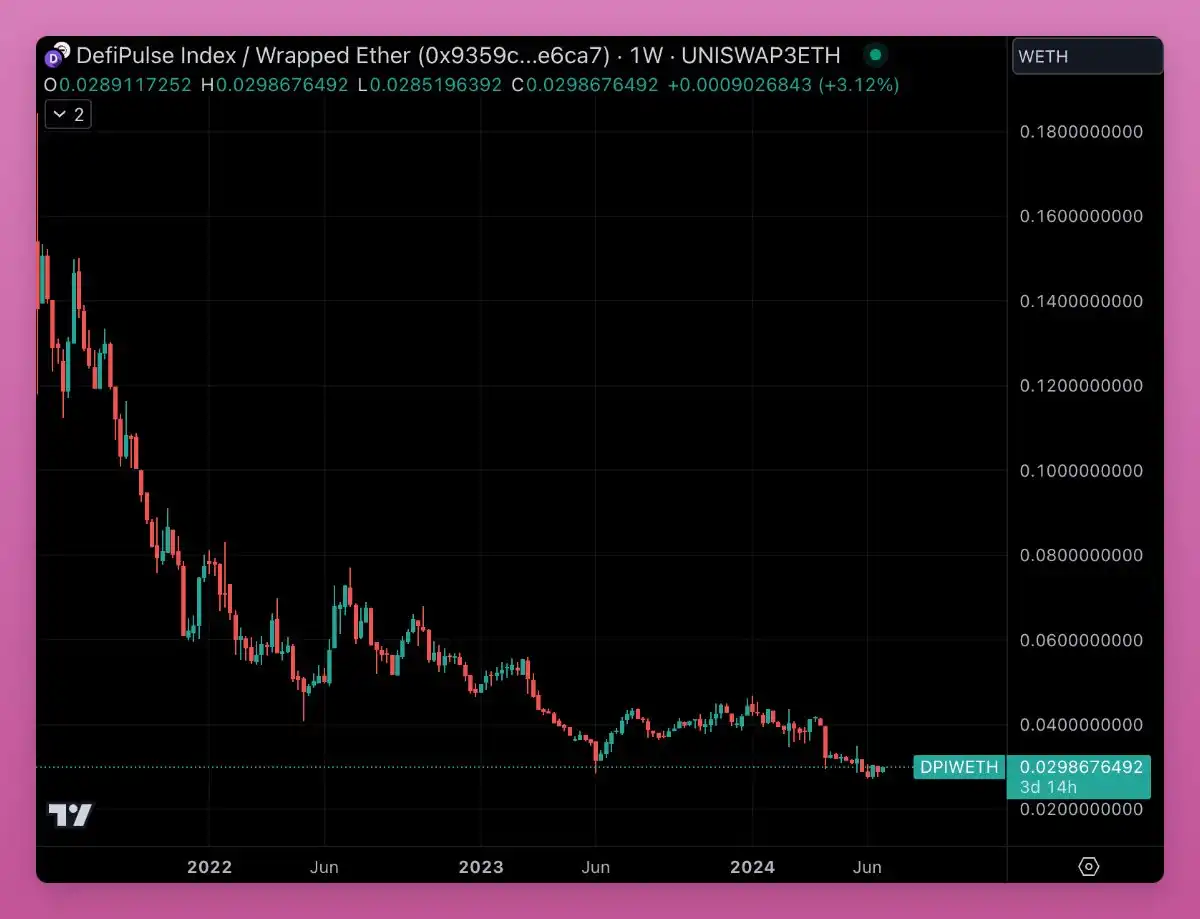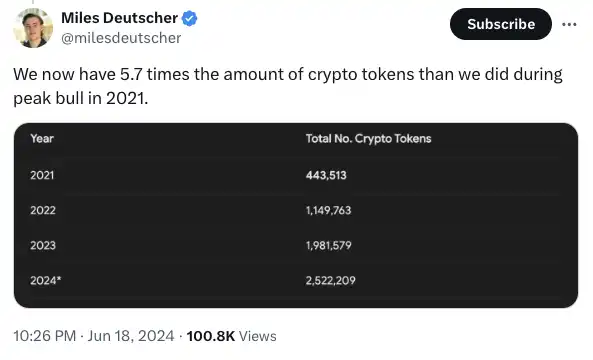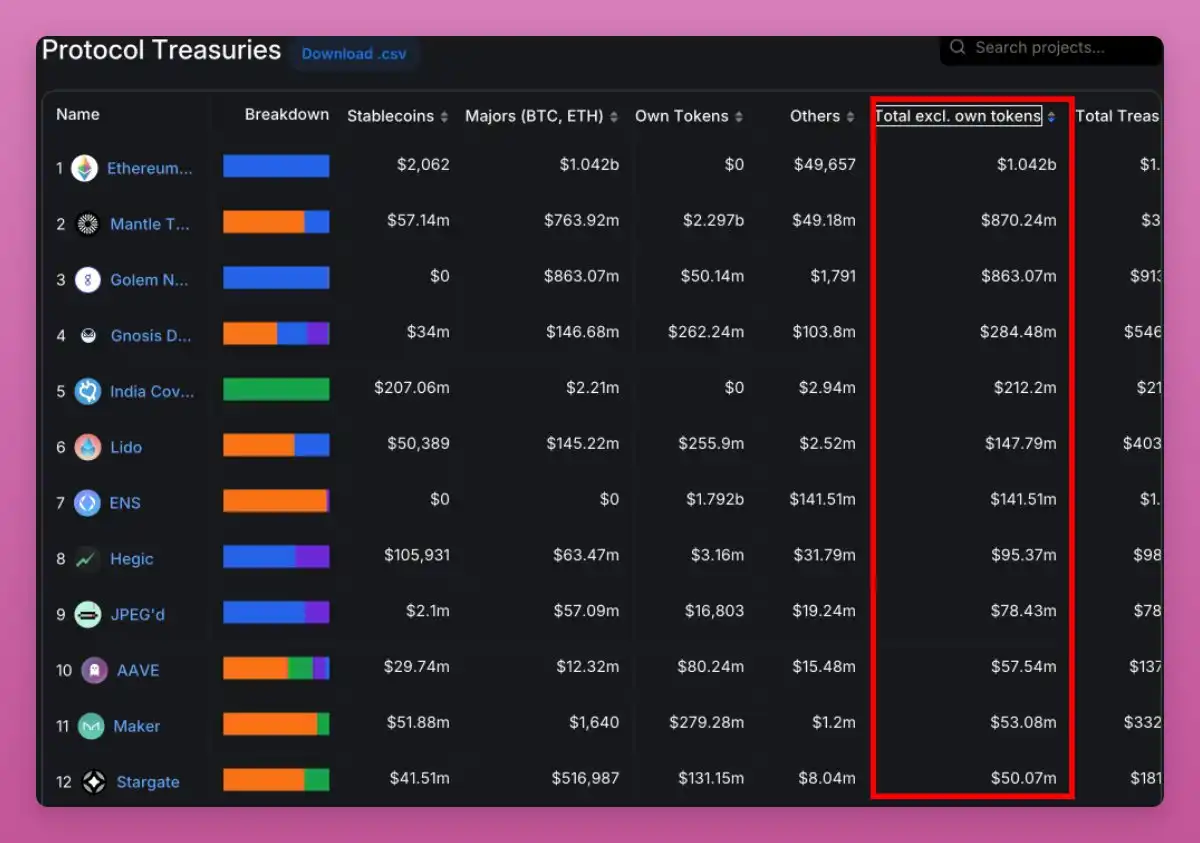Authors: Ignas, Stacy
Translation: Luccy, BlockBeats
Editor's Note: In this cycle, the most active areas for "degen" are airdrop mining and meme coins, while seemingly dying out are DeFi tokens. However, under the staking narrative, Pendle remains secure, having risen by about 750% in the same period, and Uniswap's fee switch may become a turning point for other DeFi protocols to emulate.
DeFi researchers Ignas and Stacy discussed recent trends and believe that the "shitcoin season" that changes the game rules has not yet arrived. However, Ignas remains bullish on DeFi. The original article is translated by BlockBeats as follows:
The OG tokens in the DeFi (decentralized finance) space seem to have died out.
But the market is about to undergo a major shift, with a new wave of FOMO set to surge into DeFi. Here are the reasons why DeFi is about to rise:
The performance of DeFi tokens has lagged far behind ETH. The DeFi Pulse Index (DPI) has been declining relative to ETH for three consecutive years. And in this cycle, ETH itself has also lagged behind BTC. DPI includes tokens such as UNI, MKR, LDO, AAVE, SNX, and PENDLE.

The only exception is PENDLE, which has risen by about 750% in the same period.
Why Pendle? The answer is multifaceted. They successfully found a strong product-market fit (PMF) during the points meta period.
Airdrop mining and meme coins are the most active areas for "degen" in this cycle.
Airdrop mining has reached a turning point: projects with low circulation initiate a sell-off airdrop event, and a high fully diluted valuation (FDV) means more tokens will continue to be sold into the market. But no one wants to buy these tokens! And behind every successful meme coin, there are 99 heading towards zero.
DeFi OG tokens are the opposite of airdrop mining and meme coins:
First, a large number of DeFi OG tokens are already in circulation in the market. Taking the market cap/fully diluted valuation (MC/FDV) ratio as an example:
- SNX - 1
- MKR - 0.95
- AAVE - 0.93
- LDO - 0.89
- UNI - 0.75
This means less selling pressure on holders. The opposite continues in token issuance: in just 6 months, we have already minted over 540,000 new tokens. Traders' attention and capital are thinly spread. However, only a few DeFi OG tokens have solid business and revenue sources. If funds start flowing in.

Meme coins thrive in a financially nihilistic and oppressive regulatory environment. However, regulatory clarity may bring about the biggest bull market, driven by the following factors:
- Shift from narrative to product-market fit (PMF)
- Clear indicators of success
- Easier access to funds
- Thriving mergers and acquisitions (M&A) market
For further reading, refer to the tweet from FelixOHartmann, Managing Partner at Hartmann Capital.
If regulatory clarity is achieved, the digital asset market may undergo a transformation in the form of the largest bull market to date. There are several prominent predictions:
· Transition from narrative to product-market fit
As there is currently no compliant way to value crypto assets, most crypto asset issuers are even too lazy to create products that can capture value. Ironically, the ability to capture value is a good litmus test to determine if the product itself truly needs enough capital to make consumers part with their hard-earned money. Instead, crypto founders often build things that consumers care little about and have to pay users tokens to use them. So something happened. The quality of construction improved, and…
· Projects will have clearer indicators of success
Currently, many digital asset valuations seem to be purely based on emotions and freely floating numbers. While most markets are certainly not efficient, as trading in stocks often deviates far from their earnings, the stock market does a pretty good job of bringing the cream to the top. Therefore, tokens with the most substantial product-market fit and earnings may begin to dominate conversations and portfolios more frequently. This in turn leads to…
· A more lenient digital asset financing environment
Digital asset funding is heavily skewed towards the private market, and the ability to raise funds after token issuance often becomes a roll of the dice depending on the market regime the founder is in. This has led to "alternative" cyclical ups and downs, with each new cycle bringing a batch of new projects that raised a fantastic round of funding in private financing and often squandered the funds or failed to properly utilize them in the next bear market, sometimes even if they actually built a good product. Then, the private market rotates to the next queue. Through this rotation, a considerable amount of redundant costs and value are discarded. Therefore, stronger fundamentals will make it easier for protocols to raise funds, while also enabling…
· A thriving mergers and acquisitions market
Throughout 2022-23, we have seen many DeFi projects being left on the sidelines, which could have been prime acquisition targets for more well-funded DeFi projects. For example, well-funded Uniswap or capital-rich AAVE may expand their products by acquiring some of the well-operating but undercapitalized participants in the on-chain perpetual contract and options market, or by facilitating the exchange of tokens with one of the leading real-world asset (RWA) protocols at a trading price of about 1% of Uniswap's market cap. The maturity of individual crypto assets and the entire market may open the door for truly savvy traders and operators to build value in ways we have never seen before in digital assets, and substantially accelerate product development and innovation, bringing us closer to adoption. For example, some Layer 1 blockchains may use mergers and acquisitions to acquire much-needed products and turn them into public goods. This will lower the cost for users while increasing the usage and fuel expenditure of the chain itself, driving the value of network tokens (the fat protocol argument expresses its relevance).
DeFi has the most clear product-market fit (PMF) in the crypto space: we trade on decentralized exchanges (DEX), borrow in lending markets, use DeFi stablecoins or LST as collateral, etc. In addition, traditional DeFi teams have a large reserve of funds—they can continue development for years without selling tokens.

The problem with DeFi tokens is that they lack practical use. However, this situation is beginning to change: Uniswap's fee switch may become a turning point for other DeFi protocols to emulate, and UNI surged after this news. Additionally, regulatory clarity may accelerate the trend of profit sharing.
Another problem is that DeFi 1.0 is too boring. But as long as the price rises, new things are always interesting. However, DeFi tokens have stood the test of time. They weathered the collapse of the COVID-19 pandemic in 2020 and the collapse of centralized finance (CeFi) in 2022. As @sourcex44 said, "The only true audit is the test of time."
I believe that DeFi tokens are currently a good choice for contrarian trading. Few people currently hold the original DeFi tokens, similar to accumulating ETH during a bear market and seeing SOL rise. So if the trend changes, only a few OG tokens can attract inflows of capital.
Timing is crucial. We are at a turning point, tired of new L2 solutions, celebrity coins, and waiting for the next big thing. Perhaps the "next big thing" will be the old-school DeFi tokens? I believe they have great potential for a breakout.
This post is a response to Stacy's question about DeFi tokens. Most of these tokens are quite boring, but if they have solid business, good financials, and an increase in regulatory clarity and token utility, DeFi could rise again.
Are DeFi tokens wrong?
You can attribute the decline in portfolio value to Mt. Gox, mining rewards, or any other black swan event. But they are just noise, the real fundamental problem lies in the following aspects:
Every market represents some kind of value redistribution among its participants. At certain points, different markets tend to converge. The ETH and BTC spot ETF is a typical example. New capital flows in, but doesn't go much further; the capital gains from trading ETFs remain in traditional exchanges.
At the same time, existing crypto users benefit from the new capital flowing into spot ETFs, and their gains are usually reinvested, which logically should lead to a shitcoin season—but this time, things are different.
Since March 2024, we have seen several major trends:
• A series of airdrops and point programs from top protocols
• Tier-2 protocols eager to announce their token sales and TGE
• Meme coins becoming a major element
• TON joining the norm in its ecosystem
A few DeFi protocols showing good growth are clearly related to the trends listed above. Now, we have this setup:
• The returns from Bitcoin and Ethereum are only partially settled in crypto.
• Given the meta, these returns are mostly reinvested in new tokens or meme coins, or used for point farming (locked in new protocols).
• Other DeFi protocols have not experienced any price movements, and holders are starting to lose hope.
• Few new protocols have an upward trend after TGE, partly due to selling pressure from airdrop recipients and a lack of new capital.
• Alts continue to bleed.
• The frenzy of meme coins continues to attract more and more investors, further diluting the potential new capital for DeFi tokens.
• Bitcoin and Ethereum are least affected, as spot ETF investors.
• TON is on the sidelines with its normative onboarding work and mini applications. Its ecosystem is not yet part of the broader DeFi.
Meanwhile, there is no next big meta in DeFi. Improvements in user experience and efficiency are important—but they do not attract new users, similar to early DeFi, NFTs, or even GameFi.
• Airdrops are not new.
• Stablecoin yields are not new.
• GameFi is not new.
• The FDV of most Web3 protocols is already quite fair, but new dApps appear every day, with terms that are more profitable, increasing the supply of protocols, but not stimulating new demand.
When the Ethereum spot ETF starts trading (possibly in early July), we will see some new capital flowing into Ethereum, and native ETH holders may start reinvesting their returns into DeFi—but the overall situation will not change much. New capital will flow into trending metas (AI, RWA, DePIN, meme coins), and DeFi OG will struggle to compete with at least ETH.
It's okay. The new season has its own new heroes. What will make DeFi great again? Basically, two things: a new (brand new) narrative and marketing.
The total market value of DeFi is $90 billion, including LST such as stETH ($3.2 billion) and DeFi stabilizers such as DAI ($5 billion). In comparison, the market value of ETH is $404 billion.
DeFi has many advantages over traditional finance, including more profitable passive income scenarios. But have you seen any well-known DeFi applications promoting their yield products to Web2 users?
When using DeFi is as simple as using classic banking apps, and DeFi starts to be promoted as the norm—we will eventually see a new DeFi season. Or, we need a new meta that will inject new capital into DeFi—similar to early GameFi, NFTs, or even DeFi itself.
This new meta will receive the most attention, and some capital will flow into a broader DeFi. Similar to how the frenzy of Hamster Rush or Notcoin drove TON's broader ecosystem. But do we have something similar now? Recently, I chatted with Ignas and we discussed current trends. Have we reached a shitcoin season that changes the game rules? No.
I know this post may be disappointing. Bullish content gets the most attention in CT, because people want to believe that their pockets will make money, I understand that feeling.
Many DeFi tokens in my portfolio are bleeding, but I want to be realistic. I doubt if DeFi tokens will reach their ATH this year. If I'm wrong, I'll be happy.
Apologies for the clickbait behavior, but I truly believe that DeFi has the potential for a major revival. The narrative in the crypto space changes quickly, and capital rotation will leave many people on the sidelines.
Currently, meme coins are in the spotlight, and you might laugh at my optimism for DeFi. However, the fundamentals are solid. What's important is that others are starting to believe in its importance, and this belief may lead to a revival faster than you might imagine. As long as DeFi outperforms other tokens for a period of time, others will experience FOMO.
免责声明:本文章仅代表作者个人观点,不代表本平台的立场和观点。本文章仅供信息分享,不构成对任何人的任何投资建议。用户与作者之间的任何争议,与本平台无关。如网页中刊载的文章或图片涉及侵权,请提供相关的权利证明和身份证明发送邮件到support@aicoin.com,本平台相关工作人员将会进行核查。




